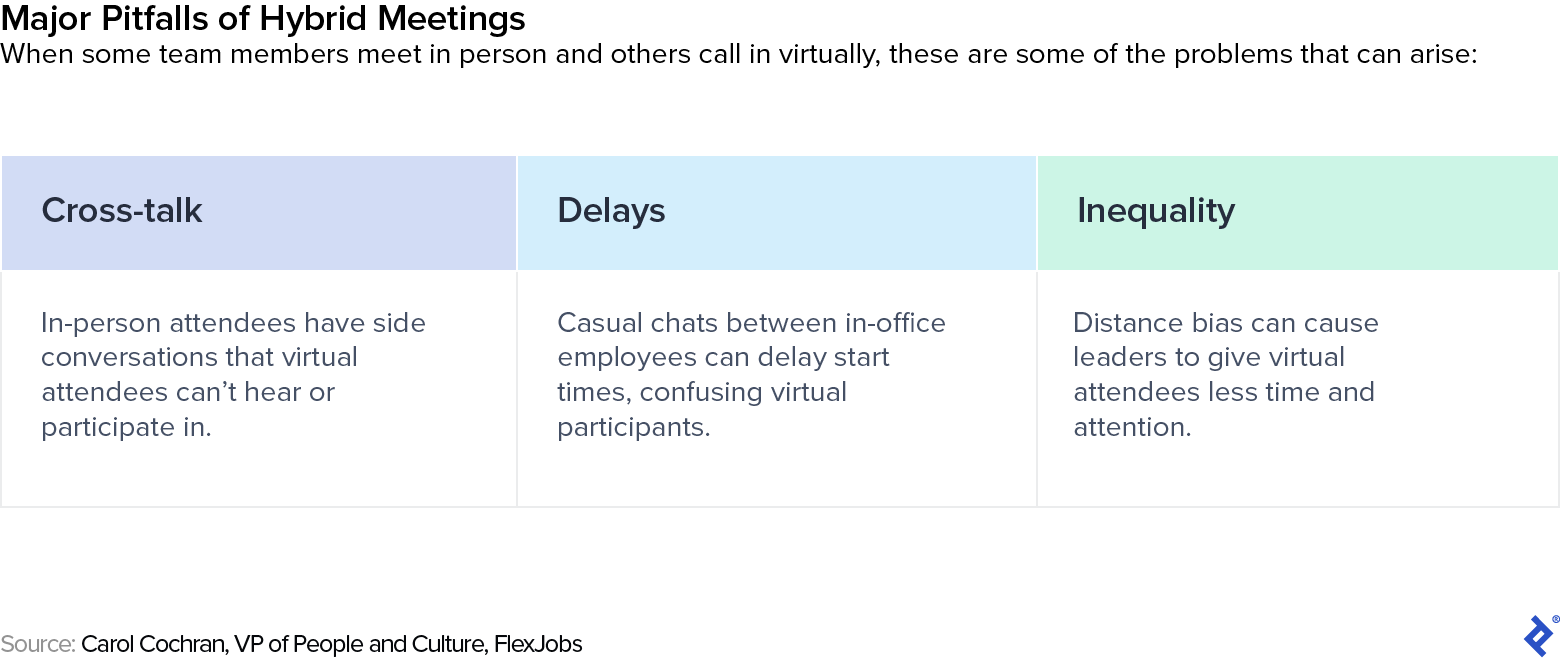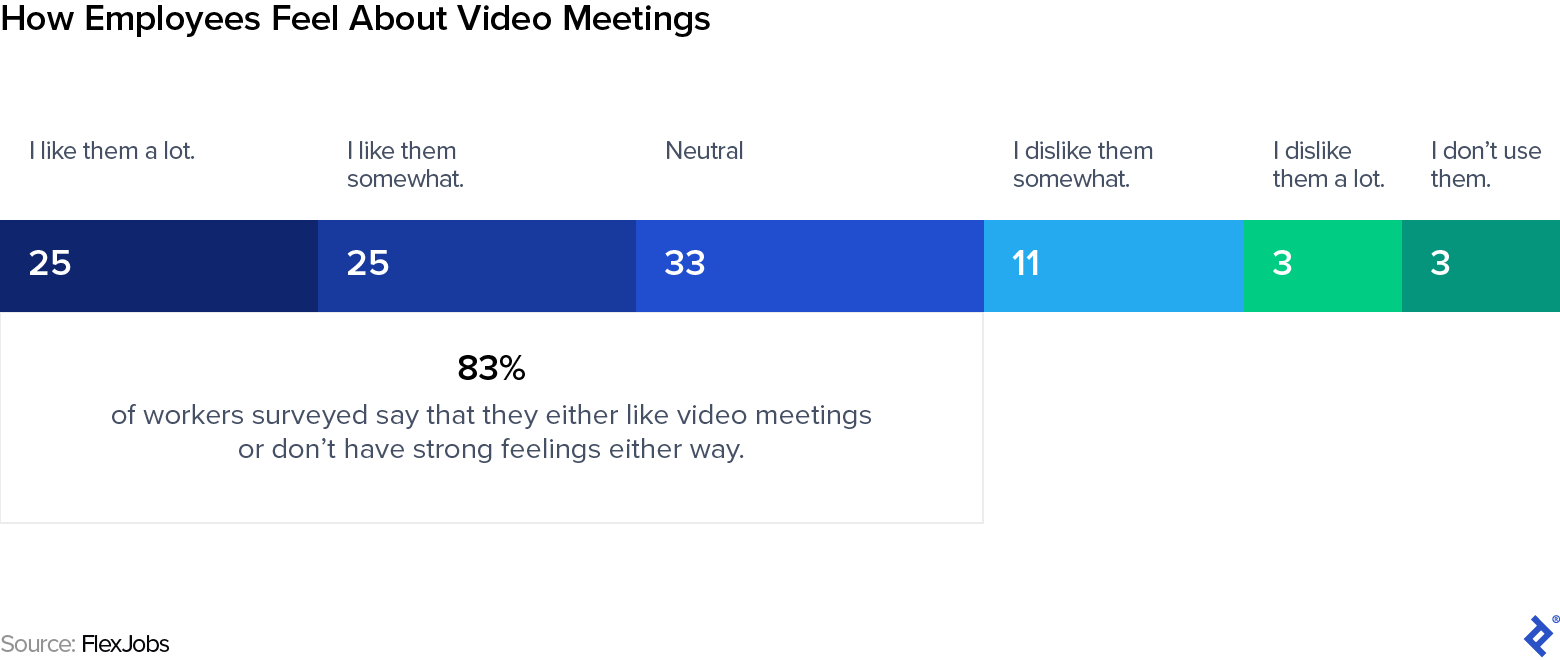Hybrid Meeting Best Practices: Should Everyone Call in Virtually?
authors are vetted experts in their fields and write on topics in which they are extremely knowledgeable. All of our content is peer reviewed and validated by world-class professionals.

Remote work isn’t new to me, though it certainly was for millions of people in 2020. As Vice President of People and Culture at FlexJobs, a company that helps workers find remote and flexible jobs from entry level to the C-suite, I’m fortunate to have held a fully remote leadership role for nearly 10 years. I also recruit, manage, assess, and coach a fully remote team.
I’m never going back to the office—and I know I’m not alone.
But because the remote model isn’t ideal for every company, many businesses are transitioning to a hybrid work model, with some people working remotely and others in the office certain days of the week or all of the time. That setup can be challenging because communication is critical to success, especially when it comes to meetings and collaboration.
People are fairly evenly split on whether being apart hurt or helped their ability to collaborate with co-workers. FlexJobs surveyed more than 2,100 respondents who worked remotely during the coronavirus pandemic and approximately one-third said collaborating virtually was as easy as collaborating in person; another one-third felt it was harder, at least in some ways; and the rest either said virtual collaboration was better, or they weren’t sure.
These results underscore how important it is for companies to help all employees do their best work in this new hybrid world, no matter where they are based. My best piece of advice for achieving this: Make every meeting virtual.
I strongly believe that when hybrid teams meet, even on-site employees who sit two cubicles from each other should dial into meetings from their desks instead of gathering in a conference room. That’s because hybrid meetings in which some people are present and others are virtual are rife with opportunities for miscommunication and inequality.

Cross-talk is a normal occurrence at in-person meetings—people have quiet side conversations or make glances and gestures across the table, constantly reading body language. Unfortunately, that excludes virtual attendees from participating and understanding the full context of what’s going on. But if everyone is at their desks, at home or in the office, there’s less of that, and everyone is on equal ground.
In-office employees sometimes also strike up casual conversations that may cause delays. It’s not fair to make remote teammates wait and wonder if the meeting time was postponed or if something else is the reason for the late start.
Perhaps the most important pitfall of hybrid meetings is that it is too easy for off-site employees to be ignored and have their ideas downplayed when they have to compete against in-person team members. This phenomenon is rooted in distance bias—a natural tendency to place more importance on people, things, and places that are closer versus farther away.
Having every participant call into meetings virtually is the best way to ensure clear communication, level the playing field, and make sure all team members get the same information and opportunities. Luckily, employees like virtual meetings more than you may think. The aforementioned FlexJobs survey found that a majority of workers either actively like videoconferences or feel neutral about them. Only 14% of the employees in our survey said they disliked virtual meetings.

Because meetings are at the heart of teams’ operations and collaboration, creating a strong set of hybrid meeting best practices is key. In addition to making all meetings virtual, here are four more of my top guidelines.
Make Your Meetings Shorter
At FlexJobs, we recently trimmed our standard meeting times from 30 minutes to 25 and from 60 minutes to 45 to encourage punctuality and provide much-needed breaks between back-to-back sessions. These standard meeting times are set as defaults in everyone’s calendars.
Send Out Agendas in Advance
To run successful meetings in a hybrid environment, establish guidelines and clearly communicate expectations. Creating meeting agendas keeps everyone on track and provides a record of team updates, to-dos, action items, and priorities. I suggest making these available on a central dashboard and sharing clear instructions with all team members on where to find them and who is responsible for keeping them updated.
Decide Whether Video Is Needed or Not
Determine which meetings will require participants to be on camera, and don’t assume video should be your default: A recent Carnegie Mellon University study found that two-person teams using videoconferencing tools fared better on problem-solving tests when their cameras were off. Communicate which meetings require video well in advance, so no one—especially remote employees—will be caught off guard.
Use Breakout Rooms
Breakout rooms, a feature offered by many virtual-meeting platforms, are a useful tool for encouraging inclusivity and collaboration between on-site and remote employees. Smaller groups that “meet” in breakout rooms give remote team members a chance to brainstorm and work more closely with their in-office colleagues.
As a champion of remote work, I want to make sure newly remote employees are heard, seen, and have the same opportunities for promotions and bonuses as their in-person colleagues. Ensuring parity and fairness for all employees makes workplaces a better place to be. However you decide to handle hybrid meetings, create a strategy and brief everyone on it. Putting a plan in place and committing to providing an equitable experience for all employees in virtual meetings will help create a successful hybrid work experience for everyone involved.
Want more information on hybrid meeting best practices? Here are more hybrid meeting tips, from Sacha Connor, Founder and CEO of Virtual Work Insider.
